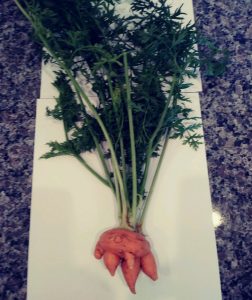It was harvest time in the Academy garden earlier this week . . . or at least that is what I thought. I was excited to see that the carrots planted last year by Mrs. Murray and Mrs. Pearce had come to maturity. I envisioned surprising the students with a snack of carrot sticks that they had grown. That was the plan.
I was shocked by the result! The stem was broad and strong and the leaves were at least a foot or more in length . . . the top of the carrot as it peered out of the garden bed looked bright orange. Every indication was that this carrot was ‘ready.’ So, I pulled, and pulled . . . and this is what revealed itself!
 I shared my discovery with Mrs. Murray and the Primary Class students who were enjoying time on the playground. They helped me to see the carrot as a claw. One friend thought they should eat it, another wanted to take it home. I explained that this carrot was very special and we needed to find out what had happened to make it grow this way.
I shared my discovery with Mrs. Murray and the Primary Class students who were enjoying time on the playground. They helped me to see the carrot as a claw. One friend thought they should eat it, another wanted to take it home. I explained that this carrot was very special and we needed to find out what had happened to make it grow this way.
The ‘carrot claw’ then made its way to the Science Lab, where students in Mrs. Marino’s class quizzically wondered what had happened. A science inquiry was begun! I share with you some of our Middle School students’ responses to the question ‘what happened to make the carrot grow this way?’
- “It was cramped in the dirt so it grew in a cramped way.”
- “I think it was caused from how the seeds were planted.”
- “Maybe it was not the right soil.”
- “Maybe there were multiple seeds close enough together to make that, and the sunlight and the rain helped it grow with the extra seeds.”
- “The water it was given wasn’t clean.”
- “I think it did not get a lot of nutrients.”
- “It might have caught a disease.”
- “There could have been a hard block of dirt that didn’t allow the carrot to grow longer and instead, it started growing sideways.”
- “Chemicals got into it.”
- “By mixing it with a different cell.”
- “I think it would grow like that because it was getting too much of what it should have and the wrong things to help it grow.”
Academy students offered some great possible explanations for our ‘carrot claw’s’ appearance. From the imaginative reaction of our young learners to the application of knowledge by our older friends — their ability to wonder, inquire and hypothesize was fully on display. The presence of this unusual carrot invited an opportunity to delve deeper into a practical problem and to think critically about what could have occurred to produce the unexpected result observed.
This week it was a carrot and I cannot wait to discover what will spark the students’ imagination and curiosity next!
United on this journey of discovery,
Dr. Susan Dempf
PS- My own investigation found that too much nitrogen in the soil causes ‘branching’ in carrots Moniruzzaman, M., et. al (2013). So, our friends with the thoughts about the soil were on the right track!
